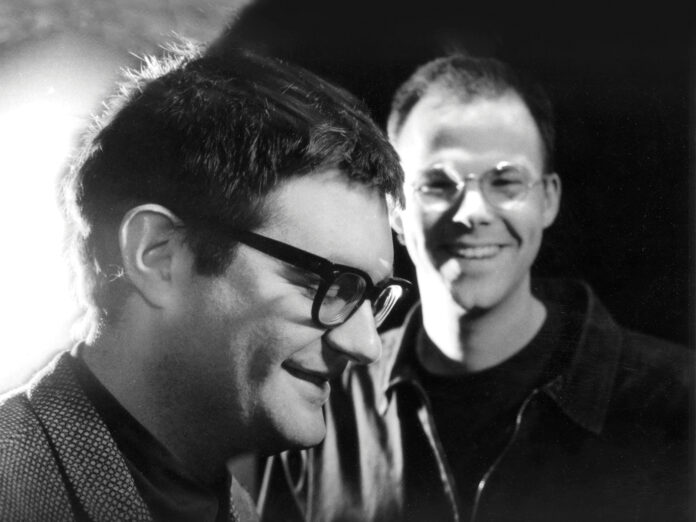David Grubbs has been thinking about this release from the moment Gastr Del Sol ceased, but a few things had to happen in the ensuing 26 years. For one, Grubbs and Jim O’Rourke had to reconnect in person in Tokyo back in 2016. Then, an excellent live recording of the band’s final performance was unearthed from the Canadian Broadcasting Corporation archives, captured in 1997 at the Festival International de Musique Actuelle de Victoriaville in rural Quebec.
David Grubbs has been thinking about this release from the moment Gastr Del Sol ceased, but a few things had to happen in the ensuing 26 years. For one, Grubbs and Jim O’Rourke had to reconnect in person in Tokyo back in 2016. Then, an excellent live recording of the band’s final performance was unearthed from the Canadian Broadcasting Corporation archives, captured in 1997 at the Festival International de Musique Actuelle de Victoriaville in rural Quebec.
JONI MITCHELL IS ON THE COVER OF THE NEW UNCUT – ORDER YOUR COPY HERE!
But let’s travel back even further, to 1991, when Gastr Del Sol emerged out of Bastro, Grubbs’ previous post-hardcore band (hence the name: Bastro becomes Gastr del Sol when embedded into Gato del Sol, the name of the racehorse who won the 1982 Kentucky Derby.) Prior to that, Grubbs had cut his teeth playing guitar in Louisville’s Squirrel Bait, moody atonal ’80s punk that presaged math rock and contributed to the birth of post-hardcore (the other major band to come out of Squirrel Bait was of course Slint, a foundational force for anxious, introspective, quiet-loud-quiet post-rock). With each group Grubbs’ interests became more expansive yet more esoteric, and less overtly rock.
Grubbs had relocated to Chicago in 1990, and after Bastro ended drummer John McEntire and bassist Bundy K Brown went on to help shape the future of post-rock with Tortoise. But before that the trio created the first Gastr Del Sol album, 1993’s The Serpentine Similar. Bastro were fast and loud, but Gastr took those post-hardcore impulses into an avant-garde direction with the beginnings of their electroacoustic experimentation and Grubbs’ minimalistic, dissonant piano. The following year, McEntire and Brown both left to join Tortoise, ushering in the arrival of multi-instrumentalist, composer and producer Jim O’Rourke. The core lineup of Gastr Del Sol was thus solidified, existing just long enough to leave an indelible mark with a handful of incredible studio albums and assorted miscellaneous releases.
All of their work is studded with innovation, and an interest in the formal possibilities of music expressed in a patchwork of tradition and exploration. Electronic and acoustic live side by side, O’Rourke’s tape manipulation up against virtuosic guitar from both, the improvisation of jazz mixing with the composition of contemporary classical and the traditional language of folk. Grubbs’ voice and surreal, cryptic lyrics introduced yet another slanted element. It’s a cerebral mix but the guitar interplay is often sprightly and the atmosphere utterly cinematic – the best example of the latter is the mesmerising and impressionistic “Our Exquisite Replica of ‘Eternity’” from 1996’s Upgrade & Afterlife. Their excellent final studio album, Camoufleur, is less abstract but still avant-garde, a chamber pop album that would get classified as post-rock. It arrived in February 1998, but the band had already come to an end by then, O’Rourke having quit within a couple of days of finishing mixing the album. It was an abrupt ending to a fascinating band, and nothing has ever come out of the Gastr Del Sol vaults – until now, thanks to this new boxset from Drag City, home of Gastr Del Sol and related works from both members ever since.
We Have Dozens Of Titles gathers up previously uncollected live material (much of which comes from that final performance together) with music from obscure compilations, singles and EPs. O’Rourke mastered, and in some cases remastered, all the music and it sounds appropriately fantastic. The album opens with an early extended instrumental version of Camoufleur’s “The Seasons Reverse”, performed live at the Victoriaville fest. Sans drums and vocals, the song becomes more meditative but no less alluring, in large part due to the magnetic guitar part and haunting piano.
A version of “Ursus Arctos Wonderfilis” from the first album was recorded live in the studio in NYC and a guitar-duelling, drawn-out interpretation of “Dictionary Of Handwriting” from the “Mirror Repair” EP comes from the Yttrium Festival in Chicago in 1996, but the other two live tracks are from the Victoriaville set. This version of “Blues Subtitled No Sense of Wonder” (the source of the lyric which gives this boxset its title, per O’Rourke’s suggestion) is purely instrumental and relentless in a pensive yet grand way, but it’s “Onion Orange” that is the album’s most striking piece of all. An 18-minute odyssey from Grubbs’ first solo album that is just guitar in its original form, here it’s transformed into an otherworldly expanse with O’Rourke’s scintillating electronic additions, opening a window into an alternative but impossible future for Gastr.
Standouts from the previously released material include “Dead Cats In A Foghorn”, a mournful and melancholic collaboration with sound artist/percussionist Günter Müller, named after Ezra Pound‘s description of futurist music; a wholly abstracted version of “The Bells of St Mary’s” recorded for a Christmas compilation released by Sony Japan; and “The Harp Factory On Lake Street”, a 17-minute experimental orchestral piece that is part ambient, part jazz and entirely compelling.
“Quietly Approaching” and “At Night And At Night” were both written for compilations; Grubbs recalls that the former is the first Gastr song that felt, to him, like it was really developed in the studio, in the sense that it had no relation to what they would do on stage. “The Japanese Room At La Pagode” comes from a split with the avant-garde violinist and composer Tony Conrad, while “20 Songs Less” is actually a 7” from 1993, offered as a single track.
The choice of pieces tells a story, though not in chronological order. “20 Songs Less” is the ninth track in the boxset, but it marks O’Rourke’s very first involvement with Gastr. Not only do several of the songs come from their final performance together, but the boxset opens and closes with the first and last songs, respectively, from that performance. There’s a real narrative sense that their story has come full circle, but naturally it’s presented in this abstracted way, intentionally sequenced to feel like a film presenting flashbacks, in Grubbs’ view.
O’Rourke and Grubbs have both gone on to release scores of albums, both solo and in collaboration with a dizzying array of musicians and artists, in modes ranging from American primitive guitar and electronic abstraction to chamber pop and free jazz. They created lightning in a bottle with Gastr del Sol, however, progenitors of an electroacoustic flux and boundary-breaking acuity that would become a more acceptable mode of music in the years to come. Back then, though, they were the ultimate ‘What do we do with this?’ band. The answer has always been simple: just listen.
When you purchase through links on our site, we may earn an affiliate commission. Here’s how it works.



